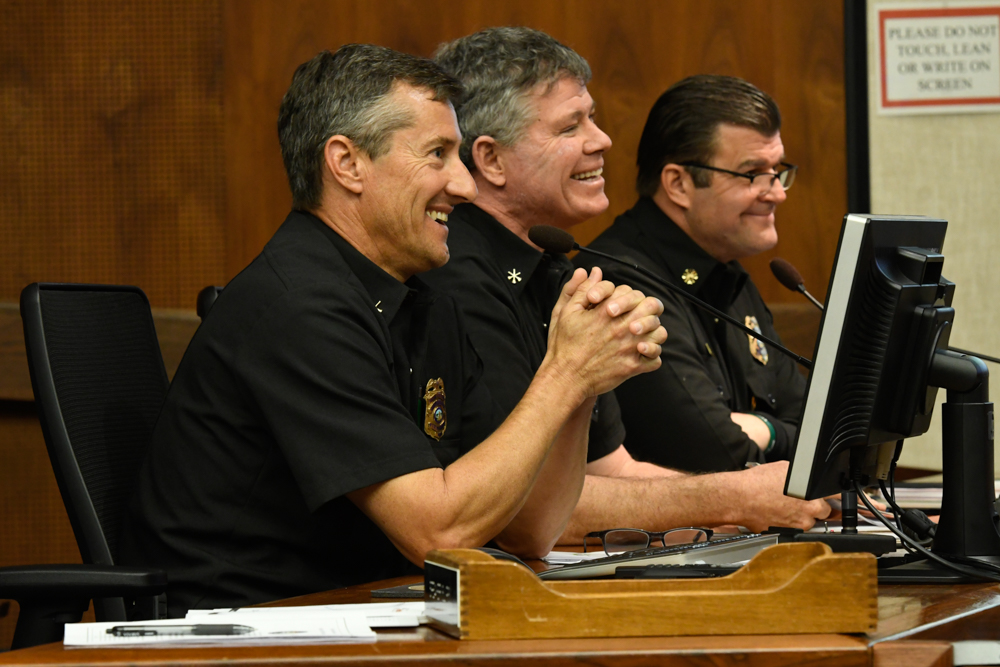County Fire Rolls Out Protection Plan for San Marcos Pass, Painted Cave Region
Education, Defensible Space, and Roadside Maintenance Top Priorities

Described as a gazette of strategy and information designed to protect an area that’s arguably one of the most vulnerable statewide to catastrophic wind-driven wildfire, a 270-page plan has been approved unanimously by the Santa Barbara County Board of Supervisors. The hefty document, titled the San Marcos Pass–Eastern Goleta Valley Mountainous Communities Community Wildfire Protection Plan, covers nearly 30 square miles, from the front-country San Marcos Foothills to the Paradise Canyon backcountry, and including the chaparral-surrounded Trout Club and Painted Cave residential areas. The plan took more than two years to craft and went through 10 versions, according to Santa Barbara County Deputy Fire Marshal Rob Hazard, who headed up the effort and presented the plan before Tuesday’s vote by the board.
Boiled down, explained Hazard, the protection plan aims to “enhance community-wide preparedness and protection” through a bevy of recommendations, from public education and beefed-up evacuation plans to brush clearing and home hardening, among others. The work also officially identified wildland-urban interface areas within the plan’s 19,588-acre boundary, which helps free up future federal grant dollars if and when the county sets aspects of the plan in motion. “[This plan] is not a commitment to any particular action,” clarified County Counsel Mike Ghizzoni. It simply collects all the priorities of the communities in its scope; if the county moves forward, any aspect of the plan would be subject to the normal flow chart of approval.
Supervisor Joan Hartmann stressed that the document serves as a valuable template for other county regions, including the Gaviota Coast, another mountainous expanse of drought-ravaged chaparral.
All said, the plan covers 12 communities, 16 recreation facilities, 1,121 structures, and 7,322 residents in an area that hasn’t experienced a major wildland blaze since the Painted Cave Fire of 1990, an act of arson that burned 5,000 acres, destroyed more than 400 structures, and killed one civilian.
While the plan emphasizes the importance of an individual home’s defensible space — a closely cropped buffer zone between the house and surrounding trees and shrubs — it also recommends more than three dozen potential “fuel treatment projects,” which would clear brush around community areas and roadsides along critical evacuation routes, equaling 250 total acres (1.2 percent of the plan’s scope). Another 522 acres of private fuel treatments, 183 acres of County Fire treatments, and roughly 800 acres of U.S. Forest Service fuel breaks — all existing — are also cited for maintenance and monitoring.
Hazard also stressed the need for “consistent vegetation management along Highway 154.” According to 75 years of data, 77 percent of wildfires started within 50 feet of a road. On San Marcos Pass, for example, it’s not uncommon, especially during a heat wave, for overheated vehicles to pull over onto the grassy shoulder. To help prevent an accidental ignition “really only requires a small buffer of 10 feet,” Hazard said, adding, however, that such vegetation clearance needs to be diligently maintained. “Aggressive management of dry [roadside] grasses is one of the most important things we can do.”
Therein lies an issue, offered Lee Chiacos, the Trout Club’s vegetation manager. Addressing the board during the public-comment period, he explained that many wildfire starts along roadways have been quickly extinguished by community members highly tuned in to the dangers of tall grass on a hot day. “We can’t keep depending on luck,” he said, politely urging Caltrans to do a better job keeping road shoulders clear of dangerous fire fuels. “We need to make it a priority for Caltrans to be part of this comprehensive plan.”
Painted Cave resident Phil Seymour emphasized that the plan “is a living document” that ought to be steadily updated as new information becomes available. Advances in evacuation planning, for example, are likely to emerge from last year’s Camp Fire tragedy in the Northern California town of Paradise. As for the plan’s long road to Tuesday’s approval, Seymour said, “It represents the values of the people who actually live in the area.”



